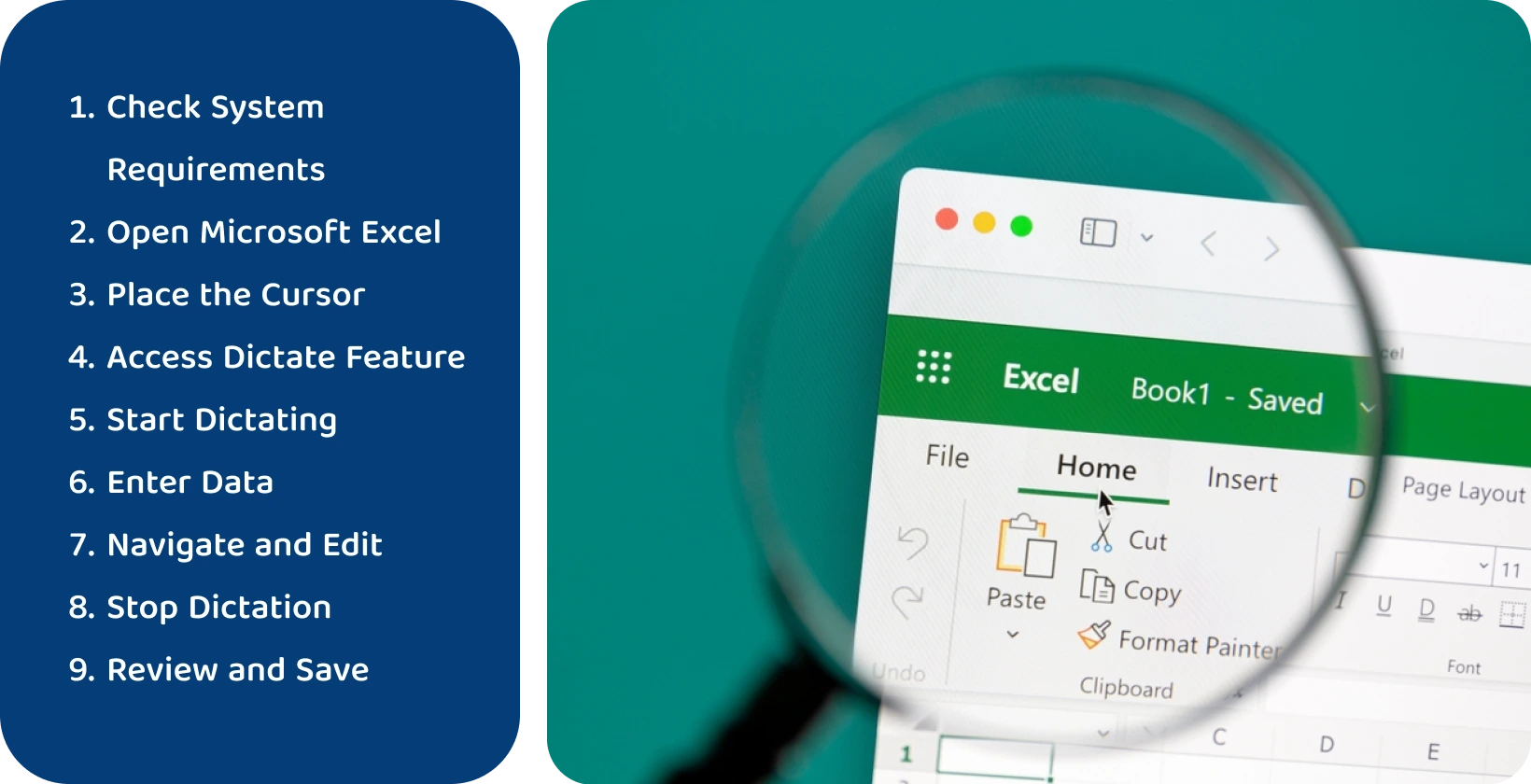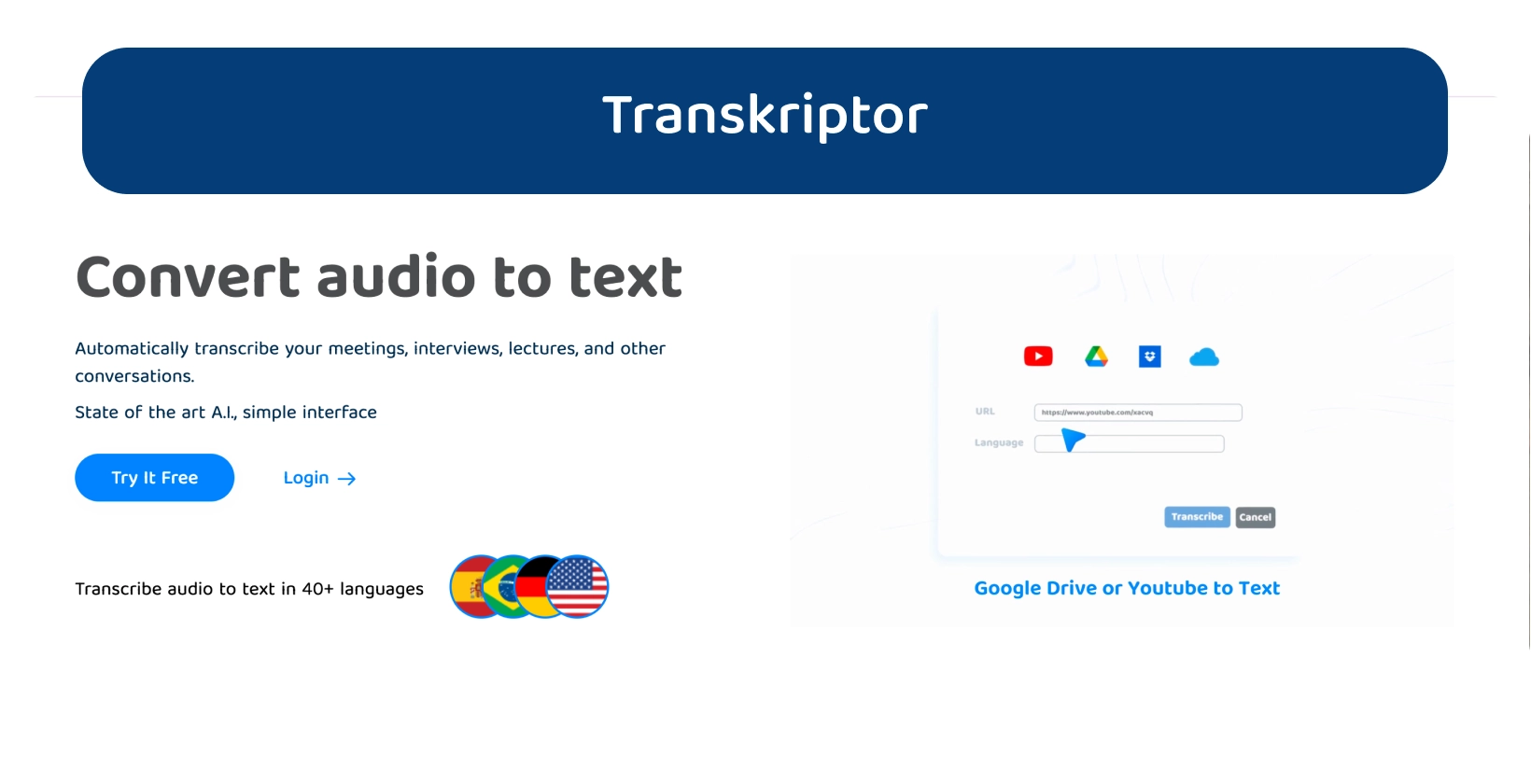For those who need to ensure the highest accuracy in transcription outside of Excel, Transkriptor is the ideal speech-to-text solution. With its sophisticated speech-to-text capabilities, Transkriptor excels in delivering precise transcriptions that users can trust for their important documents.
The 9 steps to dictate in Excel are listed below.
- Check the System Requirements: Check the system requirements and be sure that they are proper for dictating in Excel.
- Open Microsoft Excel: Find and open Microsoft Excel on the computer.
- Place the Cursor: Place the cursor on the Excel cells to be dictated.
- Access the Dictate Feature: Press the 'Windows' key and 'H' simultaneously on the keyboard to access the dictation feature.
- Start Dictating: Start speaking after activating the dictate feature.
- Enter Data Using Voice Commands: Speak the content clearly into the microphone to input numbers, dates, or text.
- Navigate and Edit with Voice Commands: Navigating the Excel interface and editing cells rely on traditional keyboard and mouse interactions.
- Stop Dictation: Press the 'Windows + H' keys again to stop the dictation feature in Excel.
- Review and Save: Check for accuracy in numbers, text, and formulas, ensuring everything has been entered as intended. Click on 'File' and then choose 'Save' or 'Save As' to store the document in the desired location.
Step 1: Check the System Requirements
Excel users must ensure that their system meets the requirements before using dictation in Excel. A stable internet connection is essential, as Excel's dictation feature relies on cloud-based services for speech recognition.
The user's computer should have a minimum of 128 MB RAM and a Pentium processor with at least 300 MHz speed. The operating system needs to be Windows 10 or Windows 11. Additionally, a compatible version of Microsoft 365 or Office must be installed. A high-quality microphone is crucial for clear voice input and accurate transcription.
Step 2: Open Microsoft Excel
Users first need to open Microsoft Excel on their computer to use the dictation feature in Microsoft Excel. They should locate the Excel icon on their desktop, the Start menu, or the taskbar.
Once found, Excel users should click on the icon to launch the application. They are able to open a file by clicking on 'File', then 'Open', and navigating to the desired file if users have a specific workbook to work on. Users are able to start with a new, blank workbook by selecting 'New' and then 'Blank Workbook'.

Step 3: Place the Cursor
Users must position the cursor in the cell where they want the dictated text to appear in Excel. They move the cursor by clicking on the desired cell with the mouse or using the keyboard arrow keys for navigation.
The selected cell becomes active, indicated by a surrounding border, where the dictated content will be inputted. Users must ensure that the correct cell is selected before starting the dictation to avoid data being entered incorrectly.
Step 4: Access the Dictate Feature
Users should press the 'Windows' key and 'H' simultaneously on their keyboard to access the dictation feature in Excel. This keyboard shortcut activates the dictation feature , making it ready to transcribe spoken words into text.
A microphone icon typically appears after pressing 'Windows + H', indicating that the system listens for the user's voice input. Power users should ensure their microphone is connected and functioning correctly before starting. Users are able to start speaking once the shortcut activates dictation. Excel will begin converting the spoken words into text in the selected cell.
Step 5: Start Dictating
Users are ready to start dictating after activating the dictation feature in Excel. They should speak clearly and at a moderate pace to ensure the accuracy of the transcription. It's beneficial for Excel pros to articulate numbers, functions, and specific Microsoft Excel terms distinctly. They should also dictate punctuation where necessary, using phrases like 'comma', 'period', or 'new line' to format the text as desired.
Excel converts the spoken words into text and displays them in the selected cell as users talk. Excel fans should monitor the transcription in real-time to confirm that Excel accurately captures the dictated content.
Step 6: Enter Data Using Voice Commands
Users enter data using voice commands while dictating with Excel. They speak the content clearly into the microphone to input numbers, dates, or text.
Spreadsheet users employ predefined Microsoft Excel voice commands for specific operations or formatting. For instance, saying 'add' or 'plus' inserts a '+' symbol, and 'equals sum' starts a SUM function. Power users say 'new line' to insert a new line within a cell.
Step 7: Navigate and Edit with Voice Commands
Dictation in Excel primarily supports speech-to-text conversion and does not provide navigation or editing functions through voice commands. While users are able to efficiently input data and formulas using voice, navigating the Excel interface and editing cells still rely on traditional keyboard and mouse interactions.
Users should continue to use standard keyboard shortcuts, arrow keys, and mouse clicks for cell selection, moving between worksheets, and making edits. These traditional methods remain essential for effective Excel usage alongside dictation.
Step 8: Stop Dictation
Users press the 'Windows + H' keys again to stop the dictation feature in Excel. This action deactivates the microphone, signaling Microsoft Excel to stop transcribing speech into text. Excel users must ensure they have finished speaking and that all desired content has been accurately transcribed before stopping dictation.
The microphone icon disappears or indicates that it is no longer active once dictation is halted, confirming that the system is no longer listening for voice input. Users are able to simply press 'Windows + H' once more to reactivate the feature.
Step 9: Review and Save
Excel Pros should meticulously review the transcribed text in the spreadsheet after ceasing dictation in Excel. This involves checking for accuracy in numbers, text, and formulas, ensuring everything has been entered as intended. Spreadsheet users should correct errors or misinterpretations during dictation to maintain data integrity.
Users save the Excel file once they are satisfied with the accuracy of the data entered. This is done by clicking on 'File' and then choosing 'Save' or 'Save As' to store the document in the desired location. Power users are able to also use the keyboard shortcut 'Ctrl + S' for a quicker save. Regularly saving the document prevents data loss and secures the user's work.

What is Dictation in Excel?
Dictation in Excel is a powerful feature that directly transforms spoken words into written text within a spreadsheet. It serves as a tool for users to input data, create lists, or compose extensive text without typing. This feature utilizes advanced speech recognition technology to accurately transcribe the user's spoken words into the active cell in real-time.
Dictation in Excel means enhanced productivity and a more intuitive way of data entry for the user. It's particularly beneficial for capturing large amounts of text, reducing the physical strain of typing, and allowing Excel pros to focus on the content rather than the input method. This feature streamlines workflows, making data entry faster and more accessible for users at any skill level.
Why Choose Dictation for Excel?
Choosing dictation for Excel empowers Excel fans with efficient, hands-free data entry. It significantly reduces the time and effort involved in typing, especially for lengthy text entries or complex datasets.
Users input data more naturally and quickly by speaking, making multitasking more manageable. This feature is especially beneficial for spreadsheet users with typing difficulties or physical constraints, as it offers an accessible alternative to keyboard use.
Dictation also minimizes errors associated with manual typing, as users focus solely on the content without being distracted by the mechanics of typing. It's an excellent tool for streamlining workflows, as Excel pros populate spreadsheets while engaged in other tasks, ensuring productivity remains high.
But if you're looking for more than just data entry in Microsoft Excel, consider taking your productivity to the next level with Transkriptor . It is not just a transcription tool; it's your versatile meeting assistant via Meetingtor. Meetingtor attends the meetings on your calendar, then records and stores them.
Transkriptor easily transcribes every word spoken in these meetings, regardless of the source, and even handles video transcriptions. Whether it's a conference call, an in-person meeting, or a recorded video, Transkriptor ensures you have accurate transcriptions and boosts your productivity.
Is Your System Ready for Excel Dictation?
The user's system must meet certain specifications to use Excel dictation effectively. The computer should have a minimum of 128 MB RAM and be equipped with a Pentium processor that operates at 300 MHz or faster. The operating system should be either Windows 10 or Windows 11.
The system must have Microsoft 365 or a compatible version of Office installed. A high-quality microphone is essential for optimal performance. This ensures that the speech-to-text conversion is accurate and minimizes the chances of transcription errors.
Tips for Clear and Accurate Formula Dictation in Excel
Excel users often encounter challenges when dictating formulas. These difficulties lead to errors and wasted time. These issues are common, causing frustration and inefficiency in spreadsheet tasks impacting productivity.
There are some ways to reduce mistakes while dictating in Excel. These tips are listed below.
- Use Clear and Slow Speech: Articulate each word distinctly and maintain a steady pace while speaking.
- Use Specific Commands for Accuracy: Use precise terminology for functions, cell references, and operations.
- Practice Dictation Skills: Regularly practice dictation skills to master formula dictation in Excel.
- Familiarize the Voice Commands: Familiarize with the specific voice commands the feature recognizes to ensure accuracy in Excel formula dictation.
- Customize Voice Recognition Settings: Customize voice recognition settings to optimize formula dictation in Excel.
- Review and Edit: Always review and edit the transcribed text for accuracy after dictating formulas in Excel.
Use Clear and Slow Speech
Excel users should articulate each word distinctly and maintain a steady pace while speaking for clear and accurate formula dictation in Excel. This approach minimizes recognition errors and improves the accuracy of the transcription.
Clear enunciation ensures that Excel's speech recognition software accurately interprets each term, especially for formulas or data-specific terminology. Speaking slowly gives the software sufficient time to correctly process and transcribe the spoken words.
Users significantly improve the reliability of formula dictation, leading to a more efficient and error-free data entry process in Excel by focusing on clarity and deliberation in speech.
Use Specific Commands for Accuracy
Users should utilize specific voice commands to enhance accuracy in formula dictation in Excel. This involves using precise terminology for functions, cell references, and operations. For example, stating 'equals sum open parenthesis' initiates a SUM function.
Excel fans should also use clear commands like 'plus', 'minus', 'times', and 'divided by' for mathematical operations. Explicitly stating 'close parenthesis' at the end of a function ensures the formula is correctly interpreted.
Users should ensure that Excel accurately recognizes and applies the intended formulas by employing these specific commands, leading to precise and error-free computations.
Practice Dictation Skills
Users should regularly practice dictation skills to master formula dictation in Excel. Starting with simple phrases and gradually progressing to complex formulas helps in honing accuracy.
Excel fans should frequently practice standard Excel functions and operations to familiarize themselves with the specific terminology that the dictation feature recognizes. Regular practice sessions enable them to adapt their speech patterns naturally for optimal dictation results.
Over time, this practice increases speed and precision in entering formulas, making users more proficient and efficient in utilizing Excel's dictation for complex data entry tasks.
Familiarize the Voice Commands
Users should familiarize themselves with the specific voice commands the feature recognizes to ensure accuracy in Excel formula dictation. Knowing the exact phrases for commands, functions, and operators is crucial.
Excel fans should review and memorize commands like 'equals', 'plus', and 'minus', and function names like 'sum', 'average', and 'count'. Understanding how to articulate cell ranges and references is also essential.
Familiarity with these voice commands allows Excel pros to dictate formulas efficiently, reducing the likelihood of errors and ensuring that Excel interprets the dictated formulas correctly.
Customize Voice Recognition Setting
Users should customize their voice recognition settings to optimize formula dictation in Excel. This involves adjusting the microphone settings for clear input and configuring speech recognition to understand the user's unique speaking style better.
Users should also ensure that the language settings match their spoken language and dialect. Regularly updating these settings and providing feedback to the system when misinterpretations occur will improve recognition accuracy over time.
Users enhance Excel's ability to accurately transcribe spoken formulas by tailoring the voice recognition settings to their preferences and speech patterns. This leads to a more seamless and efficient data entry process.
Review and Edit
Users should always review and edit the transcribed text for accuracy after dictating formulas in Excel. Careful inspection of the entered formulas is crucial to identify and correct any misinterpretations or errors made by the dictation feature.
Power users should verify that all functions, cell references, and mathematical operators are correctly transcribed and logically structured. Editing immediately after dictation ensures that any mistakes are promptly rectified, maintaining the integrity of the data and computations.
This review process is a critical step in ensuring that the formulas perform as intended, making it an essential practice for accurate and reliable data management in Excel.

Improve Excel Formula Dictation with Transkriptor
For those seeking enhanced accuracy and efficiency in transcribing audio or dictating formulas outside Excel, Transkriptor emerges as the ideal solution. Its advanced speech-to-text capabilities are specifically designed to deliver precise transcriptions, providing users with reliable outcomes for their important documents and projects.
Unlike Excel's dictation feature, Transkriptor excels in accurately capturing every detail and nuance of spoken content, making it superior for tasks requiring high transcription accuracy.
Say goodbye to limitations and enhance your productivity by trying out Transkriptor today !


